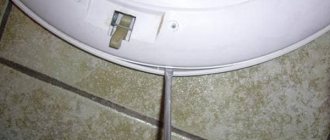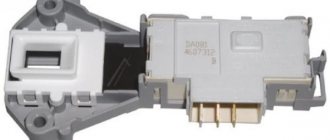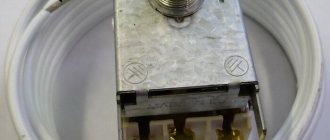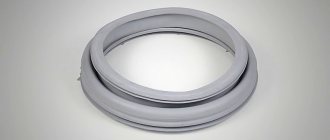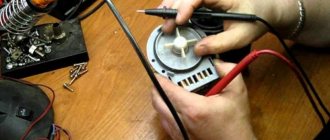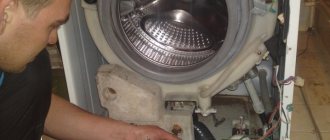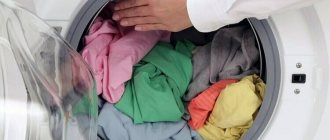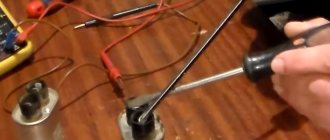Lock device
Note that there are a large number of variations of locks. Manufacturers of washing machines install different locks on their models, which differ in shape, size, and method of fastening. They also differ in their operating principles. There are mainly two types used:
- thermal;
- electronic.
One of the UBL options
Thermal UBL
At the heart of the thermal lock is an RTS resistor and (or) a bimetallic plate. After closing the hatch and starting the washing program, a voltage of 220 volts is supplied to the resistor. It begins to heat up quickly and simultaneously heats the plate, which bends.
As a result, it blocks the hatch hook using a latch, preventing it from opening during the wash cycle. The bimetallic plate also closes the control contact, as a result of which the selected program begins to be executed.
The diagram and principle of operation of such a lock is shown in the figure below.
Note that markings in the form of letters: N, L and C are often present on the UBL contacts, which makes it easier to check. Instead of an RTS thermistor, a winding made of high-resistance wire can be used. And also two resistors are used in some models, which does not change the principle of operation.
Let us repeat that locks vary in shape, size and fastening, and if you need to purchase them, you need to select them according to the product number of the machine.
Simple thermal lock
This type of lock opens itself after the wash is completed. This is both a plus and a minus. The main disadvantage is that the opening takes place after 2-3 minutes, since the bimetallic plate needs time to cool and take its original shape, thereby releasing the tongue that holds the door. Most washing machines have a light indicator for holding the hatch.
Expert opinion
I work in the household appliance repair industry. Extensive experience in restoring washing machines and dishwashers.
Ask a Question
Important! Neglecting the cooling time leads to breakage of the lock mate, which is located directly in the door.
Such UBLs are used in inexpensive models “Indesit”, “Ariston”, “Beko”, “LGi”, “Samsung”, “Ardo”, “Whirlpool”.
Electronic lock
An electromagnet is added to such a locking device, which is controlled by pulses coming from the module. And also in such UBLs there may also be an RTS resistor. In this case, the thermistor with a bimetallic plate closes the control wire, and the electromagnet moves the latch that blocks the hatch.
The castle is shown schematically in the figure below.
Sometimes such a UBL is called instantaneous, because locking and unlocking occur instantly. This is an undeniable advantage.
Such devices are installed on models of the mid-price level and above, such as: Electrolux, Zanussi, Kandy, Bosch, Siemens, AEG. There is only one drawback: the verification is difficult.
A hatch with such a UBL can be opened only if the following conditions are met:
- the machine is connected to the electrical network;
- none of the programs are running;
- there is no water in the drum;
- The engine does not rotate.
Note that washing machines with such locks are equipped with emergency opening devices, which are usually located in the area of the drain pump filter cover.
Burnt electronic lock
Reasons for lock failure
There are several reasons why the door lock of a washing machine breaks.
- Firstly, this is the wear of bimetal plates as a result of prolonged use of the equipment. As a result of regular deformation, their functional properties are lost.
- Secondly, the reason may be a short circuit.
In some cases, the problem may not be with the UBL. If the washing machine has finished working, but the door does not open, the triacistor on the central board responsible for the operation of the lock may be faulty. In this case, voltage continues to flow to the locking device and as a result the door remains locked.
Examination
At home, you can only fully check the thermal UBL. To do this, you will need a multimeter, a screwdriver (slotted or Torx) and an electrical extension cord.
First, pull the device out of the case. To do this, remove the collar from the cuff and pull back the edge next to the lock. Then unscrew the two screws that secure the lock to the body and pull it out. We pull off the chip. UBL is ready for diagnostics.
Expert opinion
I work in the household appliance repair industry. Extensive experience in restoring washing machines and dishwashers.
Ask a Question
Don't forget to turn off the power to the washing machine before doing this work!
Standard marking of thermal lock: N,L,C. A resistor passes through N and L. There is a certain resistance at these contacts. The remaining couples are broken up. If the contacts are numbered differently, you can tell by the resistance.
Another option is to connect the light bulb alternately to the terminal contacts, turn on the CMA and run the program. On the contacts that go to the resistor, the light will light up brightly.
Diagnostics and repair of the lock on your own
To check the serviceability of the lock, it will need to be removed. Necessary:
- Unplug the washing machine.
- Open the hatch, bend the cuff, pry up the clamp and remove it.
- Pull the cuff to the side to gain access to the lock.
- Unscrew the fasteners securing the device.
- Disconnect the wiring and pull out the UBL.
This method is suitable if the door opens. Otherwise, you need to open the base panel on the front of the washing machine and find the emergency cable for opening the hatch. It is usually yellow or red and is located near the filter. If the cable is missing, you need to unscrew the fasteners holding the top cover, remove it, and then put your hand between the body and the tank, find the lock latch by touch and unlock it. Now you can open the door and begin removing the UBL.
Now you can start checking the blocker using a multimeter. To determine where the neutral and common contacts are located, you will need a diagram of the lock. Hatch locking devices are produced by various companies that arrange the contacts in their own way. Without knowing the diagram, it is impossible to understand the contacts and diagnose the lock. You can find the diagram on the Internet.
At home, you can only check the thermoelement that heats the plates. To do this you need:
- Set up the multimeter to measure resistance.
- Find the neutral and phase contacts and install probes on them.
- If a three-digit number appears on the tester display, this indicates that the blocker is working.
- Now you need to move the probes to the neutral and common contacts.
- If one or zero appears on the screen, the device is broken.
If the blocker is working properly, you need to inspect it for mechanical damage or manufacturing defects.
To replace, you need to purchase a new lock. This can be done at the manufacturer's service center, in a specialized store, or via the Internet. To avoid mistakes when purchasing a part, you need to tell the seller the make and model of the washing machine.
Installing the hatch lock is performed in the following order:
- Connect the wiring to the UBL.
- Place the lock inside the washing machine and insert it into the seat.
- Screw in the fastener.
- Return the cuff to its original place and install the clamp.
If after replacing the UBL the problems continue, this indicates a malfunction of the system board. It is not recommended to repair it yourself, because it can only worsen the situation. To diagnose and repair the breakdown, you should contact a service center or call a professional.
Some washing machine owners are interested in whether it is possible to bypass the lock and start washing. Theoretically, there is such a possibility, but in this case, everyone who has access to the technology will be at risk of electric shock. Also, if you open the unlocked door during washing, there is a risk of being scalded by hot water. It is for these reasons that it is recommended to carry out repairs and replace a part that is inexpensive, rather than searching for a way to bypass the blocking.
Replacing UBL
If the lock is faulty, it all comes down to replacement. Restoring functionality does not make sense, because all damage occurs due to overheating.
You can carry out repairs yourself without involving a technician from a service center. To do this you will need: a slotted and Phillips screwdriver, as well as a little skill.
Let's take a closer look at all the actions:
- We remove the clamp. As a rule, it is a circle made of wire and a steel spring. We find it with our hands and pry it off with a slotted screwdriver. We tighten the clamp.
- We pull off part of the cuff in the area where the lock is attached.
- Unscrew the two screws that secure the lock.
- We remove the UBL by hand into the space between the cuff and the body.
- We pull the chip.
- We install a new lock.
- We put it inside the car and fasten the screws.
- We put the cuff back on, carefully working with our fingers.
- Reinstall the clamp. Here you will need the help of another person, or a second screwdriver.
Be sure to check that the hatch is closed. It should click into place.
Cuff with ul
Replacement can only be done if the door opens. Because the mounting screws are covered by the hatch. And if it is closed, then the replacement will not be possible. We will consider what to do if the hatch is blocked in another material.
Where is UBL located?
The control mechanism for opening and locking the washing machine door is located in the hatch lock housing, on the front panel. Directly in the place where the hatch hook fits. It is enclosed in a plastic case and equipped with a power connector.
The thermoelectric sensor for closing the door of a washing machine is a horizontal plate in the center of the lock structure, on the one hand, limited in mobility, and on the other, equipped with a pressing spring. Under the plate there is a thermistor, which expands from the current passing through it and pushes the plate sideways.
A little about security
The operating principle of the UBL washing machine is based on user safety. Without locking the door, no program starts, water does not pour, and the drum does not rotate.
Expert opinion
I work in the household appliance repair industry. Extensive experience in restoring washing machines and dishwashers.
Ask a Question
Theoretically, it is possible to bypass the blockage, at least the thermal one. But this is absolutely forbidden. If some “handyman” does this, he will endanger everyone who uses the machine!
Important points:
- The SMA must be grounded.
- The panel must have an RCD. It will allow you to detect possible current leaks.
- Do not lift the machine to a height, especially on a shelf. Over time, the shock absorbers wear out, and when spinning, the washer may move or even bounce.
- If you have small children, then purchase an SMA with a child lock feature and activate it.
- If water appears, call a professional.
- If the inlet hose is not equipped with the Aquastop system, then after the end of the washing cycle, turn off the water supply valve.
These simple tips will save your nerves and keep you and your loved ones safe.
Where is UBL located?
The control mechanism for opening and locking the washing machine door is located in the hatch lock housing, on the front panel. Directly in the place where the hatch hook fits. It is enclosed in a plastic case and equipped with a power connector.
The thermoelectric sensor for closing the door of a washing machine is a horizontal plate in the center of the lock structure, on the one hand, limited in mobility, and on the other, equipped with a pressing spring. Under the plate there is a thermistor, which expands from the current passing through it and pushes the plate sideways.
Operating principle and types of locks
Today, two types of locks are commonly found:
The first type is used less and less. Its main drawback is that the lock only works properly as long as there is electricity. If the light is turned off, the washing machine will not be unlocked.
The operating principle of a bimetallic lock is very simple: voltage is applied to the thermal element and heats it up. The hot thermocouple heats up the bimetallic plates; under the influence of heat, they expand and press on the lever. It goes off and blocks the door. At the end of the program, the voltage supply to the lock stops, the plates cool down, narrow and the latch returns to its original place. The washing machine hatch is unlocked.
The second type of locks has a number of advantages. Firstly, there is a delay in unlocking the hatch at the end of the program. This is necessary so that the washing machine completely drains the water and all its elements complete their work. Secondly, even if the power goes out, the lock will unlock, and the door can be opened and the laundry taken out. This type of UBL is used by many modern manufacturers of washing machines - LG, Samsung, Indesit, etc.
